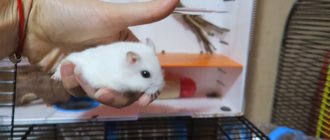03/05/2021 16,191 Hamsters
Author: Olga
Cute, charming fluffy balls - hamsters are quickly winning our hearts. And the one who got such a pet is in vain to think that there will be little trouble with it, because it does not need to be walked or trained. Hamsters also need proper care, because various parasites prey on these animals. Therefore, in order to understand why a hamster itches and what to do in this case, we suggest studying all the possible causes of this unpleasant condition.
[Hide]
Reasons for constant scratching
Needless to say, few people like it when someone constantly bites them. And domestic rodents are no exception. We’ll talk about what can cause severe itching and a situation where hamsters’ hair falls out right now.
Scabies
Scabies can be a possible reason why your hamster is going bald. Scabies is caused by microscopic mites that live in the upper layers of the epidermis or hair follicles. Ticks that parasitize hamsters are conventionally divided into skin beetles, skin beetles and itches. The former feed on keratinized skin and dandruff; the epidermis live directly on the surface of the skin, sucking blood and lymph. Itches live in the upper layer of the skin, make their moves there and feed on the subcutaneous tissue.
Ticks cause a lot of anxiety for the animal. Itches living in the upper layers of the epidermis “clog” it with their metabolic products, which are toxic to hamsters. The result is severe itching, most often in the head and neck area. The animal may try to scratch its body against the bars of the cage. As a rule, scabies is accompanied by severe scratching and wounds, because of this there is a risk of developing concomitant skin inflammation.
The hamster itches and crusts, scabs, and papules are observed on the affected areas of the skin. Remember that hamster mange is highly contagious. Therefore, if several individuals live in your cage, when symptoms appear in one animal, it must be urgently isolated. To confirm the diagnosis, as a rule, a laboratory test is carried out on the animal's hair, which falls out; microscopic mites are not visible to the naked eye.
To treat scabies, you can use Stronghold drops, which are used to treat a similar disease in cats and dogs. You just need to select the dosage very carefully, preferably with the help of a veterinarian.
Demodicosis
Demodicosis is the most common parasitic disease of hamsters. Caused by the activity of the Demodex Aurati mite, which lives in the deeper layers of the skin.
As a rule, it manifests itself as alopecia and an abundance of crusts on bald areas. Most often there are lesions in the chest and lower back. Demodicosis is not always accompanied by itching. Most often, demodicosis can be observed against the background of immune suppression or other concomitant diseases.
The diagnosis of demodicosis is made on the basis of deep scrapings. For treatment, it is optimal to use the drug Ivermectin in very low dosages. Demodicosis is not a contagious disease. However, hamsters may well become infected with feline notoedrosis (essentially the same as scabies). Therefore, be careful when keeping several animals at the same time and monitor the health of each of them. And then in the video you can look at a hamster with traces of demodicosis.
Ectoparasites
Note that external skin parasites, such as fleas or lice eaters, are uncommon in hamsters. Hamsters that have either been in contact with infected individuals or have lived on infected bedding are much more likely to “catch” fleas. For example, if in addition to the hamster you also have cats or dogs in your house, then if they have fleas, you can expect a similar parasite in the rodent.
Fleas traditionally cause severe itching because their saliva contains an irritating substance that the parasite injects into the skin with each bite. Fortunately, fleas are visible to the naked eye, so there are usually no problems with diagnosis. If infected with fleas, a hamster may have quite good general condition and a stable appetite. In some cases, flea bites provoke aggressive behavior in small rodents when they bite and scratch themselves violently.
Sarcoptes anacanthos mites, which cause the disease sarcoptic mange, are considered more dangerous ectoparasites than fleas. Sarcoptic mange is tolerated by hamsters worse than other parasitic diseases. The itching with sarcoptic mange is very strong; the hamster can cause serious wounds to itself with sharp claws. Sometimes the body of a hamster affected by sarcoptic mange looks like one continuous crusty wound with lost hair. This condition is very dangerous for a small animal and can cause its death literally within two weeks.
Allergy
Allergies are not a completely typical situation for hamsters, nor are fleas. Allergens can be food products, especially those that have high nutritional value (oats, corn). In addition, constant feeding of the same product can cause allergies such as skin irritation and itching, and hair loss.
Some hamsters are allergic to bedding, sawdust, dust, or cage cleaner.
In such cases, the animal experiences hair loss, redness of the skin, and watery eyes. If you are allergic specifically to bedding elements, then pay attention to your pet’s paws and belly. Most likely there will be bald spots, areas without fur and redness. Diagnosing allergies is always difficult; first of all, it is necessary to exclude all other causes. After this, you need to do a detailed analysis of the menu and your rodent’s environment, but this does not always help to identify a specific allergen.
Fungal diseases
Fungal diseases are popularly called lichen. However, lichen is extremely rare in hamsters. It is possible, but unlikely, that your animal will contract the fungus Trichophyton mentagrophytes, which could result in the disease trichophytosis. Ringworm, as a rule, does not cause itching; it looks like islands on the skin, completely devoid of hair. There may be redness and peeling on these islands.
To diagnose lichen, scrapings are taken and then inoculated on nutrient media. It should be remembered that lichen is quite contagious. Therefore, you should exclude contact of a sick hamster with other pets and contact it yourself with extreme caution. A person is also not immune from lichen.
What else can cause itching in a pet?
There are other reasons why hamsters itch:
- Itchy skin can be triggered by recent stress. Transportation, buying a new cage, contact with another pet - these factors negatively affect the psychological state of the rodent. The consequences of stress are different. The onset of skin itching is perhaps the most harmless thing that can happen.
- Allergies are another reason why a hamster’s body itches. Small rodents are sensitive to essential oils, which are sometimes contained in bedding. Allergies can occur due to the fact that the owner of the animal washes the cage and equipment with cleaning products or sprays perfume on himself near the pet. Hamsters have a reaction to food that has been sitting in the feeder for a long time and has become moldy. It is important to monitor the rodent’s diet and not offer it prohibited foods.
- A pet may begin to itch due to a lack of vitamins in the body. If he receives a monotonous diet - only a grain mixture, but does not eat vegetables and herbs, vitamin deficiency develops. Because of this, the condition of the coat and skin deteriorates, and immunity decreases. The rodent becomes more vulnerable to attacks by pathogenic microorganisms and parasites.
The health of a hamster largely depends on the conditions of detention and the quality of care for it. The animal will not suffer from skin diseases if the owner regularly cleans the cage, monitors the animal’s diet and protects it from stressful situations.











